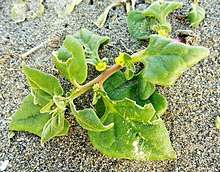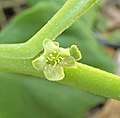Tetragonia tetragonoides
Tetragonia tetragonoides, commonly called New Zealand spinach[1][2] and other local names, is a flowering plant in the fig-marigold family (Aizoaceae). It is often cultivated as a leafy vegetable.
| Tetragonia tetragonoides | |
|---|---|
 | |
| Tetragonia tetragonoides, growing in sand in its native habitat in Japan | |
| Scientific classification | |
| Kingdom: | Plantae |
| Clade: | Tracheophytes |
| Clade: | Angiosperms |
| Clade: | Eudicots |
| Order: | Caryophyllales |
| Family: | Aizoaceae |
| Genus: | Tetragonia |
| Species: | T. tetragonoides |
| Binomial name | |
| Tetragonia tetragonoides (Pall.) Kuntze | |
| Synonyms | |
|
Tetragonia expansa | |
| Nutritional value per 100 g (3.5 oz) | |
|---|---|
| Energy | 51 kJ (12 kcal) |
2.13 g | |
| Sugars | 0.25 g |
| Dietary fiber | 1.4 g |
0.17 g | |
1.3 g | |
| Vitamins | Quantity %DV† |
| Vitamin A | 3622 IU |
| Thiamine (B1) | 3% 0.03 mg |
| Riboflavin (B2) | 9% 0.107 mg |
| Niacin (B3) | 3% 0.39 mg |
| Pantothenic acid (B5) | 5% 0.256 mg |
| Vitamin B6 | 18% 0.237 mg |
| Vitamin C | 19% 16 mg |
| Vitamin E | 8% 1.23 mg |
| Vitamin K | 278% 292 μg |
| Minerals | Quantity %DV† |
| Calcium | 5% 48 mg |
| Iron | 5% 0.66 mg |
| Magnesium | 9% 32 mg |
| Manganese | 25% 0.526 mg |
| Phosphorus | 3% 22 mg |
| Potassium | 2% 102 mg |
| Sodium | 7% 107 mg |
| Zinc | 3% 0.31 mg |
| Other constituents | Quantity |
| Water | 94.8 g |
| |
| †Percentages are roughly approximated using US recommendations for adults. Source: USDA Nutrient Database | |
It is a widespread species, native to eastern Asia, Australia, and New Zealand. It has been introduced and is an invasive species in many parts of Africa, Europe, North America, and South America.[3] Its natural habitat is sandy shorelines and bluffs, often in disturbed areas.[4] It is a halophyte and grows well in saline ground.
Description
The plant has a trailing habit, and will form a thick carpet on the ground or climb through other vegetation and hang downwards. It can have erect growth when young.[5] The leaves of the plant are 3–15 cm long, triangular in shape, and bright green. The leaves are thick, and covered with tiny papillae that look like waterdrops on the top and bottom of the leaves. The flowers of the plant are yellow,[6] and the fruit is a small, hard capsule covered with small horns.
Taxonomy
Prussian naturalist Peter Pallas described the species as Demidovia tetragonoides in 1781.[7] German botanist Otto Kuntze placed the species in the genus Tetragonia in his 1891 work Revisio Generum Plantarum, resulting in its current binomial name.[8]
This widely distributed plant has many common names, depending on its location. In addition to the name New Zealand spinach, it is also known as Botany Bay spinach, Cook's cabbage, kōkihi (in Māori), sea spinach, and tetragon. Its Australian names of Warrigal Greens and Warrigal Cabbage[6] come from the local use of warrigal to describe plants that are wild (not farmed originally).[9]
Cultivation
It is grown for the edible leaves, and can be used as food or an ornamental plant for ground cover. As some of its names signify, it has similar flavour and texture properties to spinach, and is cooked like spinach. Like spinach, it contains oxalates; its medium to low levels of oxalates need to be removed by blanching the leaves in hot water[10] for one minute, then rinsing in cold water before cooking. It thrives in hot weather, and is considered an heirloom vegetable. Few insects consume it, and even slugs and snails do not seem to feed on it.
The thick, irregularly-shaped seeds should be planted just after the last spring frost. Before planting, the seeds should be soaked for 12 hours in cold water, or 3 hours in warm water. Seeds should be planted 5–10 mm (0.2–0.4 in) deep, and spaced 15–30 cm (5.9–11.8 in) apart. The seedlings will emerge in 10–20 days, and it will continue to produce greens through the summer. Mature plant will self-seed. Seeds will overwinter up to USDA zone 5.
As food
The species, rarely used by indigenous people as a leaf vegetable, was first mentioned by Captain Cook. It was immediately picked, cooked, and pickled to help fight scurvy, and taken with the crew of the Endeavour.[6] It spread when the explorer and botanist Joseph Banks took seeds back to Kew Gardens during the latter half of the 18th century.[11] For two centuries, T. tetragonioides was the only cultivated vegetable to have originated from Australia and New Zealand.
There are some indications that Māori did eat kōkihi perhaps more regularly. "To counteract the bitterness of the older leaves of this herb, the Māori boiled it with the roots of the convolvulus (pōhue)".[12][13] The tips of the spinach can be pinched off and eaten raw or cooked.[14]
Nutrition
When consumed after boiling, New Zealand spinach is 95% water, 2% carbohydrates, 1% protein, and contains negligible fat, while supplying only 12 calories (table). In a 100 gram reference amount, the spinach is particularly rich in vitamin K, providing 278% of the Daily Value (DV). It also contains appreciable amounts of vitamin B6, vitamin C, and manganese (18-25% DV).
Gallery
 Flower
Flower.jpg) T. tetragonoides showing erect growth
T. tetragonoides showing erect growth
References
- "BSBI List 2007". Botanical Society of Britain and Ireland. Archived from the original (xls) on 2015-01-25. Retrieved 2014-10-17.
- "Tetragonia tetragonioides". Natural Resources Conservation Service PLANTS Database. USDA. Retrieved 19 January 2018.
- Tetragonia tetragonioides Invasive Species Compendium
- Tetragonia tetragonioides Flora of North America
- Tetragonia tetragonioides Flora of China
- "Tetragonia tetragonioides". The Royal Botanic Gardens and Domain Trust. Archived from the original on 9 February 2014. Retrieved 10 February 2014.
- Pallas, Peter Simon (1781). Enumeratio plantarum quae in hortoi viri illustris atque escell. Dni. Procopi a Demidof (in Russian). Saint Petersburg: Saint Petersburg Academy of Sciences. pp. 151–157.
- Kuntze, Otto (1891). Revisio Generum Plantarum. v.2. Leipzig, Germany: A. Felix. p. 264.
- The New Oxford American Dictionary (3rd ed.). 2012.
adjective (of a plant) not cultivated: warrigal melons.
- "Hungry? Try some bush tucker" (movie). The Sydney Morning Herald. 2011-06-28. Retrieved 2011-06-28.
- Low, T., Wild Food Plants of Australia, Angus & Robertson, 1991, ISBN 0-207-16930-6
- Riley, Murdoch (1994). "Maori Healing and Herbal". Paraparaumu, New Zealand: Viking Sevenseas N.Z. Ltd. pp. 7–10. ISBN 0854670955.
- "Māori Healing and Herbal - New Zealand Ethnobotanical Sourcebook". Viking Sevenseas NZ Ltd. 1994. p. 221.
- Nyerges, Christopher (2016). Foraging Wild Edible Plants of North America: More than 150 Delicious Recipes Using Nature's Edibles. Rowman & Littlefield. p. 135. ISBN 978-1-4930-1499-6.
External links
